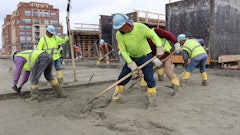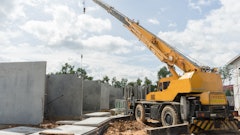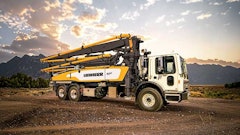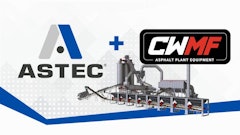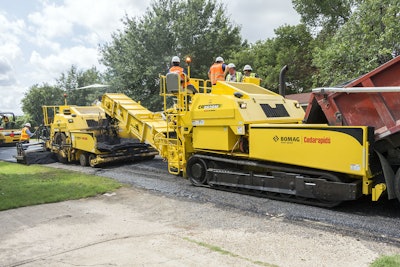
The cold longitudinal joint left down the middle of two travel lanes. Addressing the challenges associated with properly paving and compacting the unconfined joint has plagued the asphalt industry for decades. There have been many techniques developed for achieving density at the joint to meet specification, offering varying degrees of success. If not constructed and compacted properly, the longitudinal joint is a weak point in the new road, and the first failure point.
What if, instead of spending the extra time, effort and money to address the challenges of properly paving and compacting the joint, it is eliminated entirely? “If the right conditions exist, I’m a big proponent of full-width asphalt paving to eliminate the longitudinal in between the travel lanes,” says Bill Rieken, road building specialist for BOMAG. “You are eliminating a potential weak spot in the road, and you can significantly improve the mat’s quality, while reducing paving time.”
Full-width asphalt paving can be accomplished on a range of projects. At the city or county level, the contractor could pave both lanes of a two-lane city street or county road in a single pass. On the mainline, asphalt pavers will often pull widths of at least 28 ft. “This allows for paving of two 12-ft-wide travel lanes plus a small shoulder in a single pass,” explains Reiken. “It eliminates the joints between travel lanes as well as between the travel lane and the small shoulder.”
Regardless of whether it’s a two-lane road or multilane interstate, removing the cold joint enables the paving contractor to more readily achieve compaction density and smoothness across the entire mat width without density drop-off at the joint. By eliminating additional passes with the paver, it also increases paving efficiency and reduces the time required to pave the full length of the project, all-the-while improving the longevity of the road.
Contractors paving the massive Autoroute 30 skirting Montréal, Quebec, used a full-width paving technique to improve road quality during a recent lane expansion project. Nouvelle Autoroute 30 s.e.n.c., the company in charge of completing the expansion, not only had responsibility for designing, constructing, operating and financing the CAD $1.5 billion effort, it was also responsible for maintaining the road for 35 years.
It was in the owner’s best interest to construct the new roadway in the most efficient and cost-effective manner and in a way that minimized future maintenance costs. Therefore, contractors paving the highway’s asphalt portion used a Cedarapids mainline paver equipped with a screed set to a 30.2-ft width, enough to pave in a single pass the two 13.8-ft-wide travel lanes and one 2.6-ft-wide small shoulder. A Cedarapids commercial paver followed closely behind the mainline paver to pave in echelon the full shoulder, leaving a hot joint for the rolling crew to compact.
Before you start
While full-width paving offers several significant benefits, it’s not quite as easy as the contactor deciding that the company is going to pave all roads full width. Certain conditions must exist – like the ability to shut down a two-lane roadway to traffic so it can be paved in one pass – and there is some preplanning required.
“All the components of the project from plant production to trucking to the paving equipment to the rollers must work in concert together to deliver a successful full-width paving project,” mentions Tom Kiselica, road building specialist for BOMAG. “The paving train must move along consistently, so if the plant doesn’t have the capacity to keep up or not enough trucks are planned for delivery, the quality can suffer.”
One key equipment component to a successful full-width paving project is selecting the right screed. The number of crown points in the road can determine the type of screed required – hydraulically extendible or inline fixed-width – as there will be different crown points between the travel lanes for two-lane roads and between the driving lane the shoulder for wider paving.
The 10-ft hydraulically extendible screed attached to a mainline paver offer variable paving widths from 10 to 20 feet, potentially making them a good choice for full-width paving of narrower city streets, county roads and highways. Hydraulically extendible screeds like the Cedarapids Stretch 20 also have fixed-width bolt-on extensions help to expand maximum paving widths to up to 26 feet. Contractors should consult with the manufacturer to make sure crownable extensions are available to accommodate the crown point at the shoulder when paving at these extended widths.
Many times contractors will purchase a fixed-width screed, like the Cedarapids Fastach 10, specifically for paving full-width projects, especially for widths extending beyond 26 ft. “They will often set up an inline screed at the yard to meet the road’s profile and ship it to the jobsite, so it can be pulled off the trailer and attached to the paver,” says Henry Polk, paving product marketing manager for BOMAG. The efficiency gains and cost savings associated with paving in a single pass more than offset the cost of having a dedicated screed for full-width paving.
The benefit to a fixed-width screed stems from the variety of attachments offered, so a contractor can build the screed’s width to meet specific project needs. “Our Fastach 10 extension segments are available in 6-, 12-, 24-, 36- and 60-in widths and offer a pin-lock attachment design for quick installation,” adds Polk. Make sure the manufacturer offers slopeable extensions to accommodate the crown point at the shoulder.
Rieken cautions that paving at extended widths exert more forces on the screed than if the paver were paving at 12-ft widths, so he recommends some adjustments to the screed to handle these extra forces. “The manufacturer and/or distributor will work with the contractor to ensure the appropriate bracing and ballast is added, so it has the necessary structural integrity and proper ground contact pressure to withstand the added force of paving full-width,” he says. Kiselica adds, “We don’t want to run on the heel or nose of the screed. We want it to run at a slight nose-up altitude of approximately 1-1.5 degrees.”
Smooth & steady
With the correct screed selected and configured appropriately, contractors must also carefully plan for the project. The goal with full-width paving is to keep the paving train consistently moving in order to eliminate screed settling and truck-end segregation of the asphalt.
“You will use more material in the same period of time, so you must first consider your asphalt production needs,” says Rieken. The paving crew will potentially lay in excess of 500 tons of asphalt per hour, especially at widths reaching 30 ft., so the asphalt plant must have the dedicated production and storage capacity required. “A contractor may have to pull material from two different plants if one plant cannot supply enough material,” adds Kiselica.
Trucking is the vital link between the plant and paver, and the contractor must have the right number and type of trucks to ensure continuous quality paving. Fortunately with the road closed to vehicles, traffic congestion and truck transit time often isn’t impacted as much as when the trucks have to dodge in and out of traffic to deliver asphalt with partial lane closure projects.
End-dump trucks are the least preferred transport method, since they are little more than a rectangular box, allowing the mix to segregate as particles roll to the truck’s sides and ends. “Live-bottom trucks,” says Rieken, “are more preferred for their “V” shapes to reduce particle segregation. Plus they offer faster unloading into the paver’s or material transfer vehicle’s (MTV) hopper, which helps to increase truck exchange efficiency and improve continuous paving efforts.”
Paving contractors may have to anticipate doubling the rolling crew to match the increased mat width. With the largest mainline rollers like the BOMAG BW 206 AD-5 offering compaction widths of 84 in, contractors may choose to put two compaction trains – breakdown, intermediate and finish rollers – behind the paver. “A rolling crew will be dedicated to achieving spec densities for one travel lane and the other will roll the remaining travel lane and small shoulder,” explains Bert Erdmann, product manager, heavy compaction for BOMAG. “This will allow the rollers to keep up with the paver and perform their compaction tasks at the right temperature range.”
Paving thoughts
The paver will also be charged with pulling a much heavier load when paving at extended full widths. Therefore, contractors must select a paver that offers a combination of power and traction to efficiently pull off full-width paving. Both track and tire drive systems can be used, but Rieken advises contractors to carefully consider drive tire size. “The Cedarapids CR500 and CR600 Series mainline pavers are equipped with the largest drive tire available on a paver, and this helps with offering the traction required for full-width paving,” he says.
Paving contractors for the Autoroute 30 project opted for the tracked Cedarapids CR662RM RoadMix paver and MTV, equipped with a Fastach 10 inline screed. The track drive system offered the traction required for full-width paving, and it spread the weight of the fully loaded paver over a larger area to prevent rutting of the subbase on base course paving.
With its in-hopper Remix auger system replacing the slat delivery system of a traditional paver, RoadMix provided a thorough rebelending of the asphalt prior to it being channeled to the screed. With a conventional slat paver, asphalt movement is from the front of the hopper back, so any form of thermal or particle segregation of the mix in the truck will be transferred to the mat.
Conversely, the RoadMix’s two counter-rotating auger sets have a variable-pitch design that pulls material from all areas of the hopper and aggressively reblends 100% of the asphalt prior to delivering it to the screed’s spreading augers. The end result is a more homogeneous blend of asphalt delivered to the screed, which is void of both material and thermal segregation.
“We are talking about increasing quality and efficiency through full-width paving,” says Kiselica. “While it is possible to pave full width using a traditional paver, why not give your crew the best chance for success by giving the material a final remixing to eliminate any segregation that may have occurred at the plant or in transit to the jobsite?”
It is possible to complete a full-width job, especially those of narrower widths, by using just the paver to accept material from the truck. However as the paving width increases, most contractors will add an MTV to the paving train. This gives extra surge capacity to maintain continuous paving, even when there is a transport issue with material to the jobsite or a truck exchange problem. Additionally, some provide asphalt remixing to address segregation.
“The benefit offered by our RoadMix,” explains Polk, “is that it can be used both as an MTV and paver, so it gives contractors additional flexibility at the jobsite. Plus its track drive lowers ground contact pressure to less than 15 PSI, so it can be used on the critical base lift without the fear of rutting associated with MTVs using a tire drive system. Additionally, the CR662RM delivers the same asphalt remixing benefits when equipped as an MTV as it does as a paver.”
Significant payoffs
With some careful consideration and preplanning, full-width paving will yield high dividends for the contractor and traveling pubic alike. First and foremost, the road is closed to traffic, giving the contractor complete control of the construction site. This eliminates cars and truck traffic traveling at a high rate of speed adjacent to the paving area, which significantly improves safety for the work crews.
Paving full-width eliminates the weak-spot longitudinal joint running down the center of the road, boosting the road’s longevity and quality and saving the contractor the time and effort associated with rolling an unconfined edge and cold joint. This enables the contractor to achieve smooth profilograph readings across the entire mat width and better meet compaction densities without the drop-off at the joint.
Finally, full-width paving allows the road to be finished more efficiently, in less time, with fewer passes and lower cost. Reducing the time it takes to pave the road allows the road to be quickly reopened to the traveling public, which makes everyone happy.





